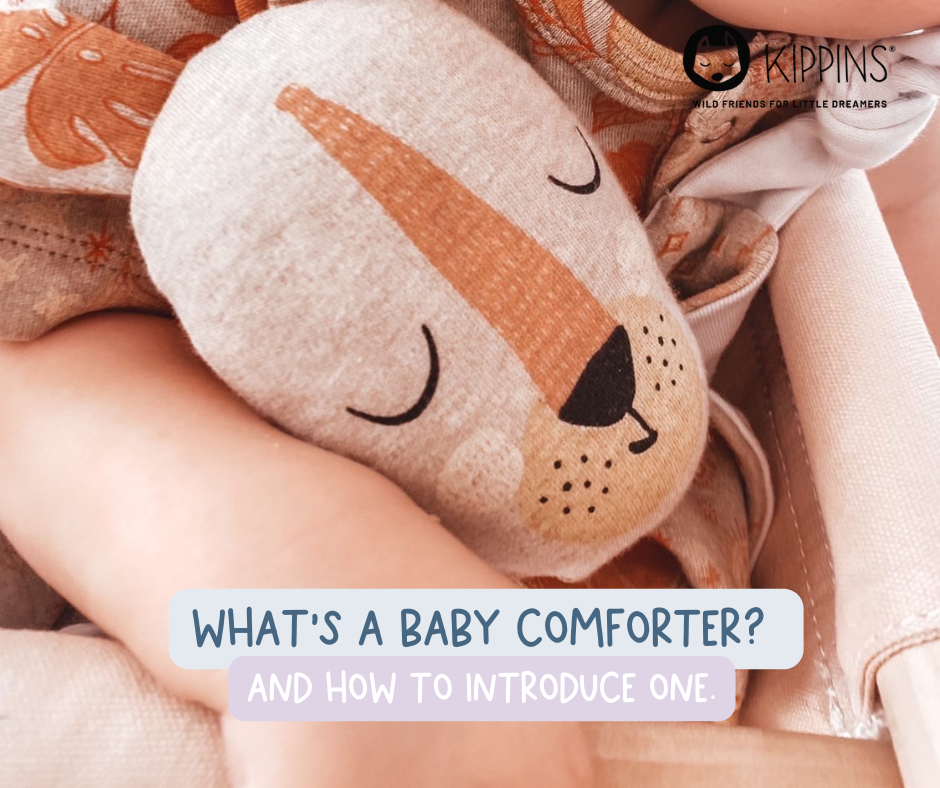What's a Baby Comforter and How Do You Introduce One?

You might have heard of a Baby Comforter, but what are they and how can they help your baby (and the rest of the family), get more sleep? We spoke to expert Sleep Consultant Kelly Martin to get the low down on all things ‘Comforter’, including how to introduce one to your baby.
What is a baby comforter and how can it help your baby sleep better?
Kelly:
A baby comforter is a transitional object that helps baby feel safe and secure when their primary caregiver is unavailable.
We all have Sleep Associations (rituals or objects that help us get to sleep), and some are more helpful than others. Sleep Associations can ‘detract’ from sleep, or support sleep in both the short and long term.
A comforter is something I refer to as a positive Sleep Association as it is something that your baby can settle to sleep with and will still be there when they wake naturally through the night as they move between their sleep cycles.
Unlike, for example, a dummy (which can get lost in the cot and which needs to be positioned correctly to be effective), a comforter stays close to our baby, can easily be grasped from a young age and won’t need you to scrabble to locate it under the cot with your phone torch at midnight. Rocking and feeding to sleep can also become distracting sleep associations, as your baby will require these each time they wake between their sleep cycles. This can quickly become exhausting.
What makes the ideal comforter?
Kelly: Confession - I personally love the Kippins brand and my daughter has been obsessed with them literally from birth. (Editor note - Kelly was a Kippins fan before we connected!).
- They’re made from organic cotton.
They will absorb your scent (unlike a synthetic comforter) – an important part of the bonding process.
- They have features that help baby self soothe.
Those 4 knots aren’t just dummy holders – babies love to chew or play with these to help themselves self soothe. Ears or beaks are also useful!
- They’re simple & the perfect size
I like that Kippins have been made with no “eyes” or buttons which can be pulled or chewed off, no loose fur or fuzzy plastic with nasties, and they’re intentionally flat – so no soft tummy/ padded bulky toys which are not recommended until 12 months plus. This is important as introducing a comforter earlier (within safety guidelines), can help establish healthy sleep habits sooner. Do not leave a toy in your baby's cot unattended until they are beyond 7m of age.
Kippins are the perfect size, and meet Red Nose Safe sleep guidelines of no more than 30x30cm in size.
- They’re practical and affordable
Being able to wash your comforter regularly is important, and I can confirm they wash brilliantly. Spares are affordable (and absolutely essential!). You will use your comforter everyday and it will get lots of love!
When and how to introduce a comforter:
Kelly: Comforters are safe to be introduced (supervised) from birth, and are safe to be left unattended in the cot from age 7 months. You can use your comforter as part of your sleep/nap routine and during the day before this.
- Put it down your top to get your scent on it. This can mean wearing it for a day or sleeping with it in your bed overnight.
- Have it close by when feeding. This also helps with scent transfer, and you can even pop some breastmilk on it (if you are breastfeeding). This allows your baby to associate their comforter with warmth, comfort and a nice full tummy.
- Make sure to have it around during their awake time to play. Let your baby play with their comforter on their playmat, popping it on their face and letting them learn to pull it off (this is an important skill for when it can be left in the cot from 7+ months). Give your baby their comforter in the car or on a walk in the pram – the more opportunities you give baby to bond with their comforter, the better – this builds the trust and rapport needed for the comforter to work as a transitional object.
- Include it as part of your wind down routine. Your nap time routine might look like this: change baby’s nappy and pop the sleeping bag on, hand the comforter to bub while still in your arms and close the curtains together. Turn on your white noise machine (this must have the capability to play all night) and sing a few sleep-time songs. Finally, pop baby into the cot calm and awake with their bestie to fall asleep.
Expert Tip: This may initially look distracting for bub, but this is a good thing. It allows your baby to drift to sleep and between sleep cycles with the comfort of their pal and not need to call out frequently for you to replicate something, such as feeding, rocking or dummy replacement between sleep cycles.
About Kelly Martin.
Kelly Martin is a Certified Infant and Child Sleep Consultant and mother of 3 girls. She has a holistic and evidence based approach to supporting families to develop and maintain healthy sleep foundations without compromising on their parenting style. She believes that sleep deprivation doesn't need to be the long-term experience of early childhood and that education and support is available.
Find out more, including some amazing sleep tips here. The topics covered include catnapping, early rising, realistic fourth trimester expectations and more.

